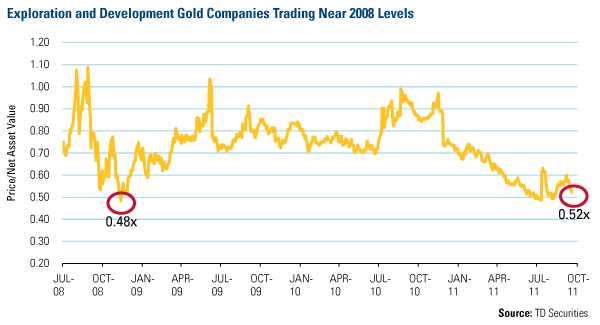Gold Market Cheat Sheet (October 11, 2011)
For the week, spot gold closed at $1,637.85, up $13.88 per ounce, or 0.85 percent. Gold stocks, as measured by the NYSE Arca Gold BUGS Index, drifted 0.29 percent lower. The U.S. Trade-Weighted Dollar Index rose 0.25 percent for the week.

Strengths
- According to Mineweb, the U.S. Mint recorded its second best sales month ever for Silver Eagle bullion coins, with sales of 4,460,500 coins in September. All-time record sales of 6,422,000 coins were recorded in January 2011. Expectations are that trade in the coins will shatter records again this year.
- This week, Qatar Holdings, which controls the wealth of the Middle East state's royal family, confirmed a $1 billion investment in European Goldfields, a London-listed miner currently developing the largest gold-mining project in Greece. Qatar Holdings noted that it will allocate $10 billion to investments in gold mining companies, which have largely underperformed gold bullion.
- The Indian festival and wedding season was kicked off by Navratri, which runs from September 28 through October 6. The Bombay Bullion Association noted that Navratri is traditionally an auspicious time for starting new ventures and given the propensity of Indians to buy gold, bullion demand is expected to jump 70 percent this year, to cross 150 metric tons. Last year, traders estimate demand during the festival season was around 90 tons. This well-timed price slump has Indian gold traders expecting a bumper festival season.
Weaknesses
- The CME Group raised platinum and copper trading margins again this week by 29 percent and 15 percent, respectively, to curb speculation in the futures market.
- Reuters highlighted that gold mining companies reported their first consecutive quarterly net hedging in 10 years during the second quarter, primarily driven by new hedges by small producers. It is expected that the global hedge book will have its first annual net addition since 1999. Hedging helps producers lock in prices for future output, but can consequently backfire if spot metal prices rise above the hedged price.
- A normal correction in bullion averages about 15 percent and this was approximately the magnitude of the selloff during the last three weeks of September. The worst price corrections over the last decade occurred during the Global Financial Crisis of 2008, when gold corrected 24 percent from July to September.
Opportunities
- More and more, gold is being viewed as money. On Thursday, LCH.Clearnet, an Anglo-French clearing house, became the latest clearer to allow gold as collateral. This move followed the CME Group increasing the amount of gold accepted at its U.S.-based clearing house Monday from $200 million to $500 million. Investors are increasingly viewing gold as a “safe” asset, but only recently has it been considered as collateral by clearing houses. The CME Group noted this would allow market participants to better manage their risk and to take advantage of lower gold lease rates.
- Central banks are expected to buy at least 336 tons of gold this year. Influence from emerging market countries such as Russia, Thailand and Bolivia all increasing their holdings contributed to the positive figures. Central banks’ gold purchases have helped drive gold higher, boosting market sentiment and absorbing supply. In the past decade, central banks were net sellers of gold, providing 400 to 500 tons of supply to the market each year, purchasing government debt with the proceeds.
- Goldman Sachs analysts still maintain a positive outlook for gold. “As we expect gold prices will continue to be driven in large measure by the evolution of U.S. real interest rates, and with our U.S. economic outlook pointing for continued low levels of U.S. real rates in 2012, we continue to recommend long trading positions in gold and reiterate our 12-month price target of $1,860 per ounce," the Goldman Sachs analysts said.
Threats
- It was confirmed this week that the majority of Zimbabwe’s mining companies had submitted plans to transfer 51 percent of ownership to locals. This law, which is heavily contested, is primarily directed at mining firms and banks operating in a resource-rich state that has become a social disaster via government-directed economic solutions.
- The Union Cabinet of India has passed a new mining bill stipulating that coal miners are to share a maximum of 26 percent of their profits with locally displaced and affected communities, and for other miners to pay out royalties. This mining bill could reduce mining income by $2 billion, raising the costs of metal and mining companies in the country. Stock markets in India did not react positively to this, taking a hit after the announcement.
- The Occupy Wall Street protest is gaining momentum and Congress is tinkering with changing President Obama’s jobs bill to be funded with a 5 percent surcharge on millionaires. Considering that market participants tend to discount information, with the top 5 percent of the income earners accounting for 37 percent of the aggregate spending today, up from 25 percent two decades ago, the law of unintended consequences may dictate a change in spending habits.











